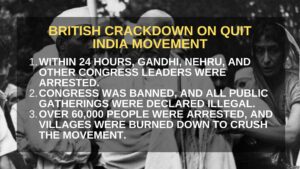The Quit India Movement, also known as the August Kranti, was a significant milestone in India’s struggle for independence. Launched in 1942 under the leadership of Mahatma Gandhi, it was a mass protest demanding an end to British rule in India. This movement played a crucial role in making India’s independence inevitable.
Why Did the Quit India Movement Start?
The movement was triggered by multiple factors, including:
- Failure of the Cripps Mission – The British government refused to grant any real autonomy to India, disappointing Indian leaders.
- Public Discontent – People were suffering from rising prices, food shortages, and the economic burden of World War II.
- Racism by the British – The evacuation of only white people from Southeast Asia during the war angered Indians.
- Fear of Japanese Invasion – National leaders wanted Indians to be prepared in case Japan attacked India.
Download notes of Emergence of Mahatma Gandhi in the National Movement
Gandhi’s Call for Action
In May 1942, Gandhi decided it was time for the British to leave India peacefully. The Indian National Congress passed the Quit India Resolution on August 8, 1942, at the Gowalia Tank Maidan in Bombay.
Gandhi’s famous words “Do or Die” became the rallying cry for Indians across the country. He also gave specific instructions to different sections of society:
- Government employees – Stay in your job but show support for the movement.
- Soldiers – Do not resign but refuse to harm fellow Indians.
- Peasants – Pay rent only if the landlord supported the movement.
- Students – Leave studies and join the struggle if they could remain firm.
British Response: Brutal Suppression
The British government acted immediately:
- Within 24 hours, Gandhi, Nehru, and other Congress leaders were arrested.
- Congress was banned, and all public gatherings were declared illegal.
- Over 60,000 people were arrested, and villages were burned down to crush the movement.

Image Source: pibindia
How Did People React?
Despite severe repression, the movement spread like wildfire across India:
- Mass Protests – People in cities like Bombay, Patna, and Allahabad clashed with the police.
- Attacks on British Symbols – Protesters targeted railway stations, post offices, and police stations.
- Parallel Governments – People set up independent administrations in places like Balia (UP), Tamluk (Bengal), and Satara (Maharashtra).
- Underground Resistance – Leaders like Aruna Asaf Ali, Jai Prakash Narayan, and Sucheta Kriplani continued the fight in secret.
Gandhi’s Fast and Public Support
In February 1943, Gandhi undertook a 21-day fast to protest against British repression. This created a massive wave of public sympathy and international attention. Even Indian officials working for the British government resigned in protest.
Who Participated in the Quit India Movement?
- Students and Youth – Led protests and demonstrations.
- Women – Leaders like Usha Mehta and Aruna Asaf Ali played key roles.
- Peasants and Workers – Went on strikes and provided resources to the underground movement.
- Government Officials – Some secretly supported the movement by leaking information.
- Muslims – Although participation was lower, they sheltered underground workers and avoided becoming informers.
Impact and Significance
- The Quit India Movement showed the British that Indians would accept nothing less than complete independence.
- It was the most intense and widespread movement in the freedom struggle.
- Parallel governments demonstrated that Indians could govern themselves.
- Although suppressed, the movement forced the British to eventually negotiate India’s independence.
The Quit India Movement was a turning point in India’s freedom struggle. It united people across the country in the fight against British rule. Even though it was suppressed, it set the stage for India’s independence in 1947.
Download notes of Political Changes After Civil Disobedience Movement
FAQs on Quit India Movement
Q1. Why did the Quit India Movement start?
A. The movement started because the British refused to grant independence despite growing unrest. War-time inflation, British racism, and the failure of the Cripps Mission added to the anger.
Q2. What was Gandhi’s role in the movement?
A. Gandhi led the movement and gave the famous call of “Do or Die.” He encouraged nonviolent resistance and later undertook a 21-day fast to protest against government repression.
Q3. How did the British react to the Quit India Movement?
A. The British responded with mass arrests, including top leaders like Gandhi and Nehru. Congress was banned, public protests were brutally suppressed, and many were killed.
Q4. What made the Quit India Movement unique?
A. Unlike earlier movements, this was a leaderless mass struggle, with grassroots participation, parallel governments, and underground activities.
Q5. Were there any parallel governments during the movement?
A. Yes, parallel governments were formed in Balia, Tamluk, Satara, and other places, showing that people were ready to govern themselves.


